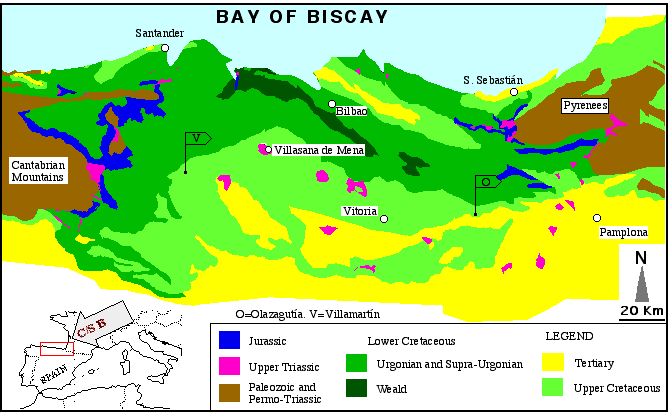
Santonian Working Group
Subcommission on Cretaceous Stratigraphy
Meeting on the Coniacian-Santonian boundary
Bilbao (Spain) -September 13 to 17, 2002
Today's date is:

100 My
 |
Santonian Working GroupSubcommission on Cretaceous Stratigraphy Meeting on the Coniacian-Santonian boundary |
 100 My |
Purpose: To study and discuss the problem of the Coniacian-Santonian boundary, and to visit the possible candidate for the GSSP boundary stratotype section at Olazagutía (Navarra) and a section at Villamartín (Burgos). Two days - September 14 and 15th - for field-trip, and one day - September 16th - for talk and poster presentation.
![]() An overwiew of the Upper Cretaceous of the Basque-Cantabrian Region
An overwiew of the Upper Cretaceous of the Basque-Cantabrian Region
![]()
| Registration: May 1st, 2002 |
|
| Local organiser: Prof. Marcos A. Lamolda |
![]()
An overwiew of the Upper Cretaceous of the Basque-Cantabrian Region
The Basque-Cantabrian Region is located in North Spain, between the Pyrenees and the Cantabrian Mountains. The Pyrenees have a Hercynian nucleus, which was regenerated during the Mesozoic. They became folded with an alpine style, constituting the actual border between France and Spain. The Basque-Cantabrian Region (BCR) has an exclusively Mesozoic alpine history which is largely affected by pronounced salt diapirism. After the main orogenic movements of Alpine age - Eocene in the region, large continental basins subsided during the Oligocene and Miocene, e. g. the Ebro Basin, which forms the southern border of the BCR.
The geological origin of the BCR is related to the opening of the Bay of Biscay. During the Cretaceous a thinned continental crust was produced by the separation of the Iberian and European plates. The separation of the two plates determined the development of the BCR on its southwest side. Depositional sequences differ both in thickness and nature of the sediments. In the central part thicknesses of several thousand metres are found (e.g., 4000 m for the Upper Cretaceous), sediments are strongly tectonized, and form the so-called Folded Basque Arc, from the western Pyrenees as far as Bilbao. Both southwards and westwards of that structural unit, tectonism is not as strong, except along the southern border in contact with the Ebro Basin. The region was part of a gulf open to the Atlantic, except during Cenomanian-Turonian times when an open connection with the Western Tethys southwards and eastwards was established.

During the Late Cretaceous the evolution of the Basque-Cantabrian Region differed locally. East of Santander is a big North-South structural feature, the Rio Miera Flexure (Feuillée and Rat, 1971) differentiating two very different areas in the BCR. The western block, which belongs to the eastern border of the Cantabrian Mountains, was very stable in comparison to central and eastern areas of the BCR. Differences are documented both by tectonic style and the thickness of the Upper Cretaceous, e.g., 1200 m in contrast to several thousand metres eastwards, as mentioned above.
The Navarro-Cantabrian Platform (the area of the CSB Meeting) is subdivided by both longitudinal (NW-SE) and transverse (NE-SW) faults resulting in a group of areas with different subsidence histories. In spite of local and/or temporary fluctuations, the Navarro-Cantabrian Platform (NCP) remained typically an outer shelf environment where deposits are mainly fine and of hemipelagic origin. The deep marine area underwent much more important transformations that trend toward a simplification and a uniformity of both the environment and sedimentation (Mathey, 1987). During the Cenomanian transgression a broad carbonate shelf began to develop, and with it a rich fauna and microflora. A Gavelinella association expanded westwards, while in the eastern, deeper areas, a nodosariid association appeared. In the northern and eastern areas, there are flysch and micritic sequences rich in planktonic microfossils. During the late Cenomanian, the NCP saw the development of a facies known as the "Flysch à boules" by French authors, consisting of marly and calcareous alternations, which are overlain by brown shales of latest Cenomanian age, characteristic of this edge of the continental shelf, and more or less coeval with the black shales of the Cenomanian-Turonian boundary from the North Atlantic region (Lamolda, 1986).
In the Early Turonian, the maximum of the transgression was achieved and the deepest facies occur in the NCP. The middle-upper Turonian regressive interval had major implications for the inner shelf, where a great diversification of sedimentary facies developed, with reef-like rudist facies in the western part of the Ebro Ridge accompanied by the appearance of a general calcarenitic facies. In the outer shelf and basinal regions there were minor sedimentary changes. Marly flysch and micritic limestones occur, and alternating marls and marly limestones; both are rich in planktonic microfossils. The ammonites (Mammitidae), echinoids, inoceramids, and some benthic foraminifera (Gavelinella s.l., Arenobulimina spp.) show temperate European affinities, whereas most of the microfauna, planktonic foraminifera (Globotruncana-like species) and ostracods, are characteristic of the Tethyan Realm.
The Turonian-Coniacian boundary marked the onset of a new cycle; locally there may be a hiatus or, as in the southwest part of the basin, there may be a regional disconformity which marks a change that is associated with a general revival of subsidence. This was accompanied by deeper facies on the whole shelf, being mainly grey marls and marly limestones, rich in cephalopods, echinoids and planktonic foraminifera. This picture continued during the Coniacian in various sedimentary areas.
A general regression started in the Late Santonian of the BCR, with its main effect on the NCP, developing a high variety of near-shore sediments, with rudists, miliolids (Lacazina-Limestone) and orbitoids occurring up to the Maastrichtian. Eventually, the uplift of the western and southern parts developed continental Garumnian facies. Gräffe (1994) gave a comprehensive overview of the Cretaceous sequence stratigraphy of the region.
![]()